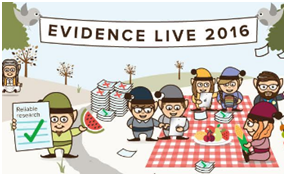In the run up to Evidence Live 2016, we are running a series of blogs by the conference speakers discussing what they will be talking about at the conference.
The tired old trope of “my evidence” vs “your evidence” is endlessly rehearsed on the social media discussions and comments sections. Powerful groups—both corporate and voluntary—deploy effective media strategies to undermine scientific claims that run counter to their interests. And now personalisation of social media means that we exist in a “filter bubble” in which we never see things we don’t already like. “Intellectual pudding,” when what we need is “vegetables” (Pariser 2011). In an era of clickbait, trolling, and sockpuppets, what chance does good quality evidence stand?
It’s worth remembering that the printing press was once decried as an agent of unreliable knowledge just as Twitter and Facebook are now (Crick 2004). Increasing numbers of (especially) young people don’t read newspapers and don’t watch broadcast news (Gottfried 2016). The internet is their first port of call for knowledge, and whether we like it or not, blog content, and other dynamic media are most likely to appear at the top of search engines and in our inboxes. And as we know, almost nobody goes beyond the first page of Google results (Chitika Insights 2013).
So, dispiriting as it might seem to some of us, we have no option but to engage with social media. Thankfully, it’s not hard, and lots of people are working hard to bring scientific evidence into this world. Encouragingly, the signs are that there is an appetite out there for accessible and reliable messages about health care.
Accessibility is key in our time-poor lives, but social media has been designed with that as a primary focus. Anyone with a smartphone can sign up for free and create a meaningful presence within minutes. What’s more, the bite-sized nature of tweets and other social posts lend themselves perfectly to brief moments during the day that need filling.
Published research has always been unusable, and despite the best efforts of groups like the EQUATOR Network, it is not improving fast. If we are serious about closing the gap between research and practice we need to dramatically improve the way important new evidence is communicated to the people who need it most.
Blogs and social media provide two vital layers of content between the research evidence and frontline practitioners. Most busy clinicians have very few opportunities each week to read a full paper, but they do have lots of spare 5-minute breaks and even more spare 5-second breaks. Reading a tweet takes 5 seconds and can alert us to an important new piece of information. Reading a blog takes 5 minutes and can summarise a reliable and clinically relevant piece of evidence, but also start to explore some of the strengths and limitations of that evidence and how it should impact on practice.
Evidence Live 2016 Preconference Workshop 21st June: Making Evidence Live – An introduction to Social Media/Blogging Workshop. A hands on approach to publishing critical appraisals of important new research using blogs and social media facilitated by Douglas Badenoch, Caroline Blaine, Andre Tomlin and Alison Turner.
Douglas Badenoch is an information specialist providing consultancy and project management services in evidence-based health care. His special interest is in improving awareness, accessibility and usability of reliable evidence in health and social care. CoI: Douglas founded and works for Minervation Ltd, a private company providing knowledge services in evidence-based health care.
André Tomlin is an Information Scientist with 20 years experience working in evidence-based healthcare. He is the the driving force behind the Mental Elf, one of a series of health evidence blogs designed to help professionals keep up to date with simple, clear and engaging summaries of evidence-based research. Find out more at National Elf Service: www.nationalelfservice.net. CoI: André is the Founder and Director of the National Elf Service Ltd; a website that features thousands of evidence-based health and social care blogs.
References:
All links accessed on 27th May 2016.
Pariser E (2011) Beware online filter bubbles, Eli Pariser TED Talk, March 2011
Crick JC & Walsham A (2004). The uses of script and print, 1300–1700. Cambridge University Press; p. 20.
Gottfried J & Shearer E (2016). News Use Across Social Media Platforms 2016. Pew Research Center.
The EQUATOR Network (Enhancing the QUAlity and Transparency Of health Research) http://www.equator-network.org
Chitika Insights (2013). Google Insights report (PDF – charts on pp. 6-7)
